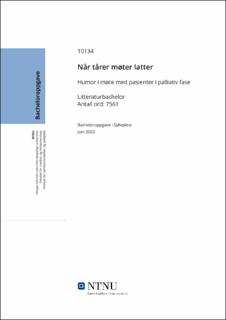| dc.contributor.advisor | Brænd, Jorunn Andrea | |
| dc.contributor.author | Reime, Ingrid Sophie | |
| dc.date.accessioned | 2022-09-01T17:19:10Z | |
| dc.date.available | 2022-09-01T17:19:10Z | |
| dc.date.issued | 2022 | |
| dc.identifier | no.ntnu:inspera:110921428:52381466 | |
| dc.identifier.uri | https://hdl.handle.net/11250/3015216 | |
| dc.description.abstract | Sammendrag
Bakgrunn: Den palliative behandlingen har vært i stor utvikling de siste årene. Palliasjon innebærer å bidra til best mulig symptomlindring og livskvalitet for pasienten. Effekten av humor i møte med pasienter er lite fokusert på i sykepleieutdanningen. Humorens kraft i helsevesenet har de siste årene fått mer fokus, og forskning viser at humor kan bidra til å redusere smerter og stress.
Hensikt: Å belyse hvilken terapeutisk funksjon sykepleiers bruk av humor har i møte med pasienter i palliativ fase.
Metode: Systematisk litteraturstudie basert på 8 forskningsartikler. Databasene som ble tatt i bruk i søkeprosessen var Medline og CINAHL. Analysen bygger på Evans analysemodell.
Resultat: Humorens bidrag til den mellommenneskelige relasjonen var gjennomgående for flere av pasientene. Flere opplevde at hierarkiet mellom sykepleier og pasient forsvant ved bruken. Humor bidrar til avledning av smerter og stress for både pasient og sykepleier, og kan mulig regnes som en terapeutisk bruk av seg selv. Humor kan også bidra til å bedre kommunikasjonen, men også hemme den. Bruken av humor må være gjennomtenkt for å unngå å fornærme eller krenke pasienten.
Konklusjon: Humor kan bli brukt som et terapeutisk hjelpemiddel i sykepleier-pasient-relasjonen dersom det blir brukt riktig til rett tid. Bruken krever et personorientert fokus. Det trenger likevel ikke inkluderes humor for å utøve god, palliativ omsorg.
Nøkkelord: humor, palliativ behandling, sykepleie | |
| dc.description.abstract | Abstract
Background: Palliative care has developed considerably in recent years. Palliative care entails providing symptom relief and improved quality of life for patients. The effect of humour when treating patients has previously been subordinated in nurse education. Health care services have in recent years focused more on humour’s positive effect, with research showing that humor can help relieve both pain and stress.
Intention: To show what therapeutic function the use of humour from a nurse can have when treating patients in a palliative state.
Method: A systematic literature study based on 8 research articles. The databases that were used in the process of searching for the articles were Medline and CINAHL. The analysis is based on Evans analytical model.
Results: The contribution of humour in interpersonal relations was consistent for several of the patients. Some of the participants experienced that the hierarchy between nurses and patients vanished when using humour. Humour can be a distraction from pain and stress for both the patient and nurse, and its use can be therapeutic in itself. Humour can both contribute and hamper communication. The use of humour must be thoroughly thought out when used, to avoid insulting or violating the patient.
Conclusion: Humour can be used as a therapeutic aid in a nurse-patient relationship if it is used in the right way and at the right time. Such use of humour takes a person-centered focus. Humour is, however, not imperative when executing good, palliative care.
Keywords: humour, palliative care, nursing | |
| dc.language | nob | |
| dc.publisher | NTNU | |
| dc.title | Når tårer møter latter - Humor i møte med pasienter i palliativ fase | |
| dc.type | Bachelor thesis | |
